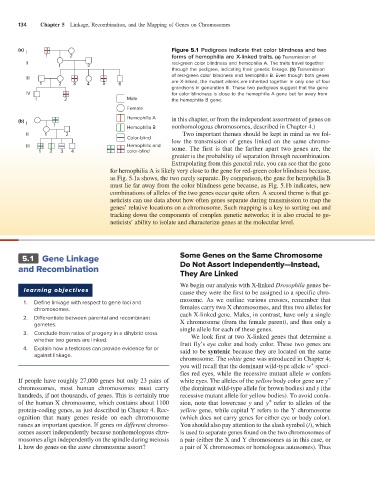Page 142 - Genetics_From_Genes_to_Genomes_6th_FULL_Part1
P. 142
134 Chapter 5 Linkage, Recombination, and the Mapping of Genes on Chromosomes
(a) I Figure 5.1 Pedigrees indicate that color blindness and two
1 2 forms of hemophilia are X-linked traits. (a) Transmission of
II red-green color blindness and hemophilia A. The traits travel together
1 2
through the pedigree, indicating their genetic linkage. (b) Transmission
of red-green color blindness and hemophilia B. Even though both genes
III
1 2 3 4 5 6 are X-linked, the mutant alleles are inherited together in only one of four
grandsons in generation III. These two pedigrees suggest that the gene
IV for color blindness is close to the hemophilia A gene but far away from
1 2 Male the hemophilia B gene.
Female
Hemophilia A in this chapter, or from the independent assortment of genes on
(b) I 1 Hemophilia B nonhomologous chromosomes, described in Chapter 4.)
II 1 2 Two important themes should be kept in mind as we fol-
Color-blind low the transmission of genes linked on the same chromo-
III Hemophilic and some. The first is that the farther apart two genes are, the
1 2 3 4 color-blind
greater is the probability of separation through recombination.
Extrapolating from this general rule, you can see that the gene
for hemophilia A is likely very close to the gene for red-green color blindness because,
as Fig. 5.1a shows, the two rarely separate. By comparison, the gene for hemophilia B
must lie far away from the color blindness gene because, as Fig. 5.1b indicates, new
combinations of alleles of the two genes occur quite often. A second theme is that ge-
neticists can use data about how often genes separate during transmission to map the
genes’ relative locations on a chromosome. Such mapping is a key to sorting out and
tracking down the components of complex genetic networks; it is also crucial to ge-
neticists’ ability to isolate and characterize genes at the molecular level.
5.1 Gene Linkage Some Genes on the Same Chromosome
and Recombination Do Not Assort Independently—Instead,
They Are Linked
We begin our analysis with X-linked Drosophila genes be-
learning objectives cause they were the first to be assigned to a specific chro-
mosome. As we outline various crosses, remember that
1. Define linkage with respect to gene loci and
chromosomes. females carry two X chromosomes, and thus two alleles for
2. Differentiate between parental and recombinant each X-linked gene. Males, in contrast, have only a single
gametes. X chromosome (from the female parent), and thus only a
3. Conclude from ratios of progeny in a dihybrid cross single allele for each of these genes.
We look first at two X-linked genes that determine a
whether two genes are linked. fruit fly’s eye color and body color. These two genes are
4. Explain how a testcross can provide evidence for or said to be syntenic because they are located on the same
against linkage.
chromosome. The white gene was introduced in Chapter 4;
+
you will recall that the dominant wild-type allele w speci-
fies red eyes, while the recessive mutant allele w confers
+
If people have roughly 27,000 genes but only 23 pairs of white eyes. The alleles of the yellow body color gene are y
chromosomes, most human chromosomes must carry (the dominant wild-type allele for brown bodies) and y (the
hundreds, if not thousands, of genes. This is certainly true recessive mutant allele for yellow bodies). To avoid confu-
+
of the human X chromosome, which contains about 1100 sion, note that lowercase y and y refer to alleles of the
protein-coding genes, as just described in Chapter 4. Rec- yellow gene, while capital Y refers to the Y chromosome
ognition that many genes reside on each chromosome (which does not carry genes for either eye or body color).
raises an important question. If genes on different chromo- You should also pay attention to the slash symbol (/), which
somes assort independently because nonhomologous chro- is used to separate genes found on the two chromosomes of
mosomes align independently on the spindle during meiosis a pair (either the X and Y chromosomes as in this case, or
I, how do genes on the same chromosome assort? a pair of X chromosomes or homologous autosomes). Thus

